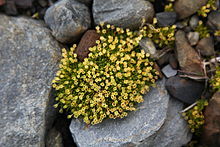Colobanthus quitensis
| Colobanthus quitensis | |
|---|---|
 |
|
| Antarctic Pearlwort at St. Andrews Bay, South Georgia | |
| Scientific classification | |
| Kingdom: | Plantae |
| (unranked): | Angiosperms |
| (unranked): | Eudicots |
| (unranked): | Core eudicots |
| Order: | Caryophyllales |
| Family: | Caryophyllaceae |
| Genus: | Colobanthus |
| Species: | C. quitensis |
| Binomial name | |
|
Colobanthus quitensis (Kunth) Bartl. |
|
| Synonyms | |
|
C. alatus, C. aretioides, C. billardieri, C. cherlerioides, C. crassifolius, C. crassifolius var. aretioides, C. maclovianus, C. meingeni, C. quitensis var. alatus, C. saginoides, Sagina crassifolia, S. quitensis, Spergula affinis? |
|
C. alatus, C. aretioides, C. billardieri, C. cherlerioides, C. crassifolius, C. crassifolius var. aretioides, C. maclovianus, C. meingeni, C. quitensis var. alatus, C. saginoides, Sagina crassifolia, S. quitensis, Spergula affinis?
Colobanthus quitensis (Antarctic pearlwort) is one of two native flowering plants found in the Antarctic region. It occurs on the continental edge, as well as the South Orkney Islands and the South Shetland Islands. It has yellow flowers and grows about 5 cm (two inches) tall, with a cushion-like growth habit that gives it a moss-like appearance.
Due to climate change, more seeds are germinating, creating a large number of seedlings and plants. Reports indicate a fivefold increase in these plants, which have extended their ranges southward and cover more extensive areas, wherever found. Deschampsia antarctica (Antarctic hairgrass) is the only other native flowering plant in the region.
Synonyms include Sagina quitensis.
...
Wikipedia
